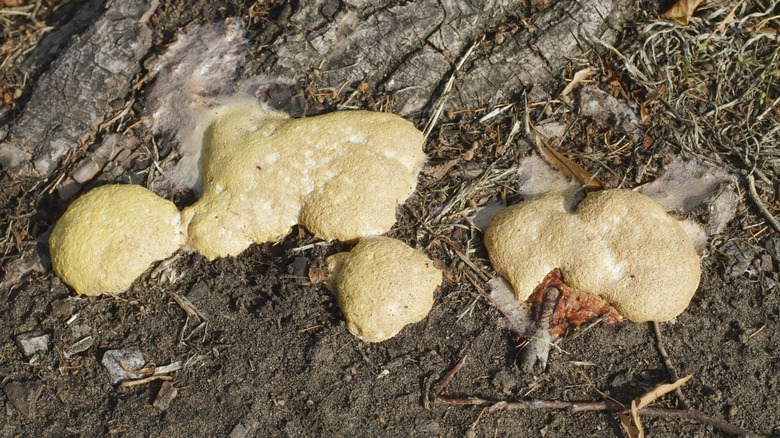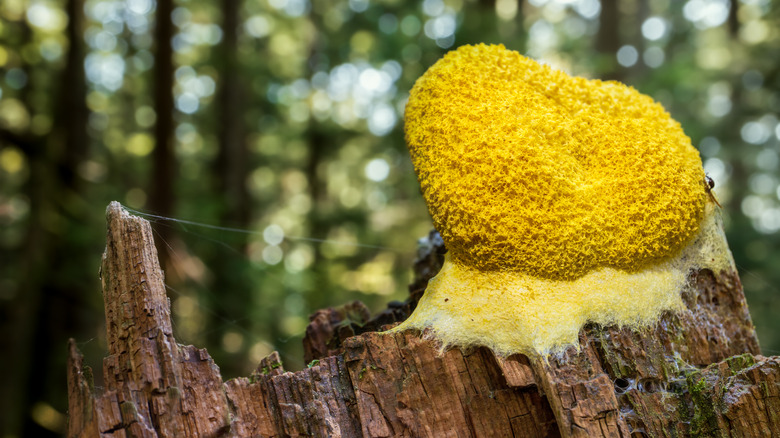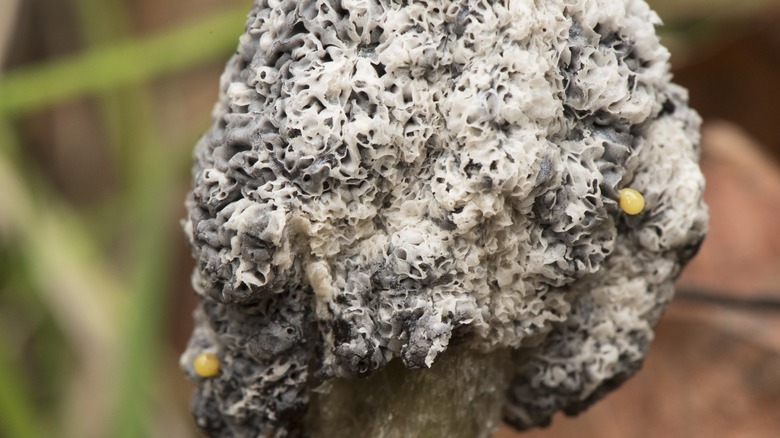What To Do About Unsightly Dog Vomit Fungus In Your Yard
You get out early into your garden that day and spot a pile of what looks like bright yellow vomit edged with sticky mucus in your freshly mulched garden bed. There might even be a few drops of blood in there. Yuck! Upon closer inspection, you realize it's actually something ... organic in nature. In fact, it looks like it's actively growing. Your yard is now home to the aptly nicknamed dog vomit fungus, Fuligo septica, also known as dog vomit slime mold or scrambled egg slime.
Dog vomit fungus prefers warm, wet weather, which is why it often appears the morning after a spring or summer rain storm, according to the Missouri Department of Conversation's online field guide. It typically doesn't live very long; you can leave it to dry up and crumble away in a few days to weeks, writes gardening expert Larry Hodgson in his blog Laidback Gardener. But if you find it unsightly, you can break it up with various garden tools, deprive it of the dampness and shade it thrives in, or start using vinegar in your garden — among other simple removal solutions.
Is dog vomit fungus dangerous?
Despite having the words "mold" or "fungus" in its common names, dog vomit fungus is not, in fact, either. Instead, it's part of the myxomycetes (slime mold) family, which is, in turn, part of the kingdom Protista, which contains other organisms like amoebas and some seaweeds, according to a 2015 article published on Wisconsin Master Gardener. Slime molds are distinct from fungi in that they don't form mycelium, though they do have spores. They spread via a hungry, decaying-matter-eating plasmodium (the bit that looks like egg white). Once the plasmodium runs out of food, it creates a typically yellow — or sometimes orange, gray, or white — fruiting body, dries out, and starts the sporulation phase. The spores, dispersed by wind, can lie inactive for years, sprouting only when the conditions for growth are right.
Dog vomit fungus doesn't number among the scary weeds in your yard to destroy right away, but it can be slippery, making it a slip-and-fall hazard for young kids or older adults with balance issues. A 2013 article published in Ann Allergy Asthma Immunol issue suggested that dry spores may pose a risk to people sensitive to aeroallergens. Occasionally, dog vomit fungus can grow colonies large enough to smother plants, according to Toronto Master Gardeners. But mostly, if you pride yourself on a tidy yard and garden, it's simply unsightly.
How to get rid of dog vomit fungus
You can break up dog vomit fungus using a rake, yard broom, or trowel. It dislodges the mold, depriving it of nutrients. Carefully wash your tool afterward to stop spores from spreading. This slime mold thrives in the damp and shade, so altering these conditions can speed up the lifecycle. In other words, turn off irrigation or water less frequently and remove overhanging trees and shrubs to bathe the area in sunlight.
You'll also want to avoid changing your mulch regularly since fresh mulch is more attractive to dog vomit fungus. Use inorganic mulch, like natural stone, rubber, or landscape fabric. Dog vomit fungus is hunted by slugs, snails, and certain beetles, so if you can encourage them in the area, do so. Additionally, you could also try spraying the mold with white vinegar. The acetic acid in the vinegar may be toxic to slim mold and its spores (as well as other microorganisms) at concentrations over 10%, as per a 2020 study published in the journal BMC Microbiology.
However, since dog vomit fungus is mostly harmless and short-lived, some gardeners simply leave it be. In fact, in some cases, it may even be beneficial for your garden. It decomposes organic material quickly into healthy soil full of plant-friendly nutrients, according to the University of Florida IFAS. That said, some slime molds have even been found to convert heavy metals to inactive forms, as per the University of Florida IFAS.


